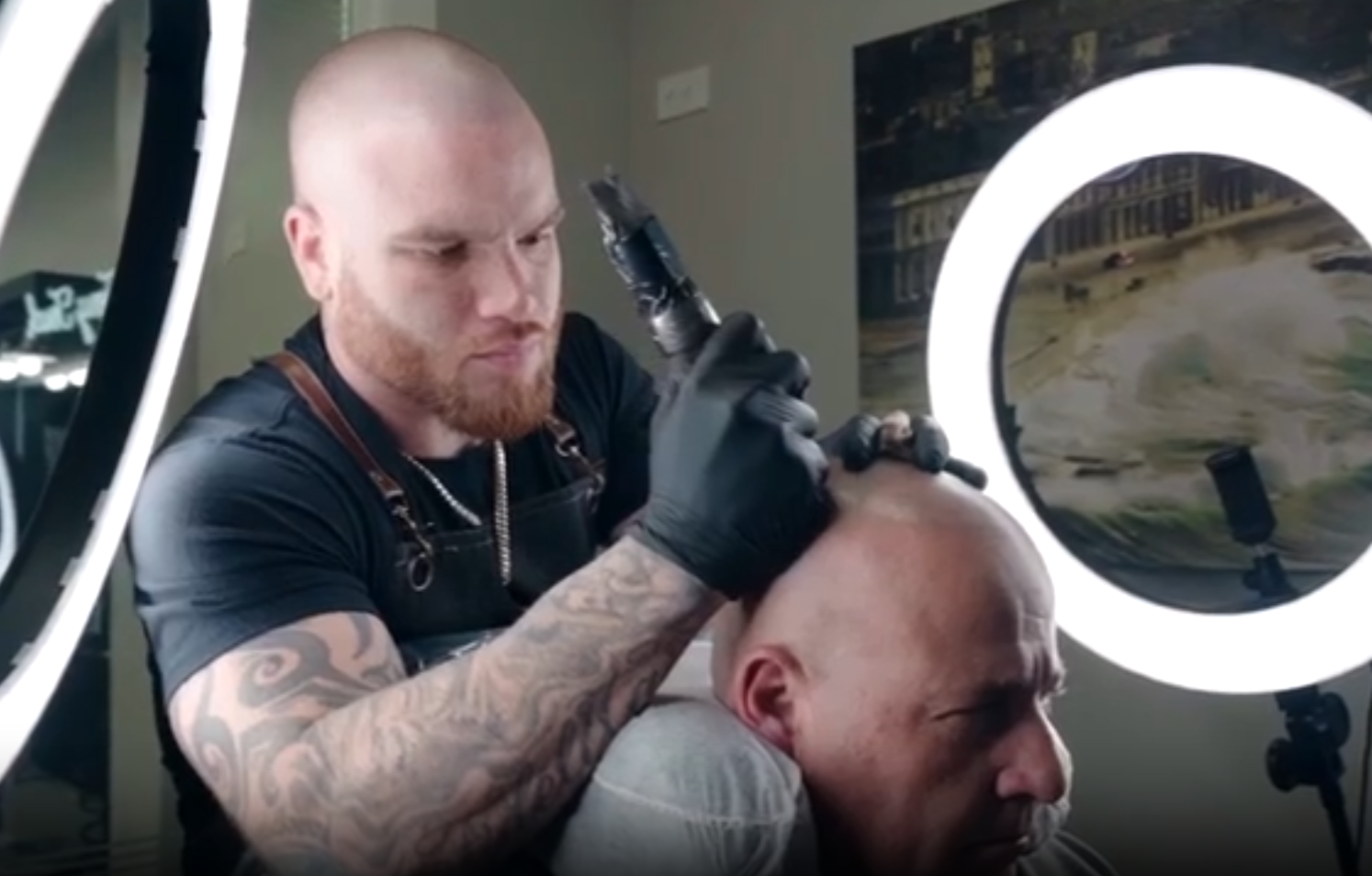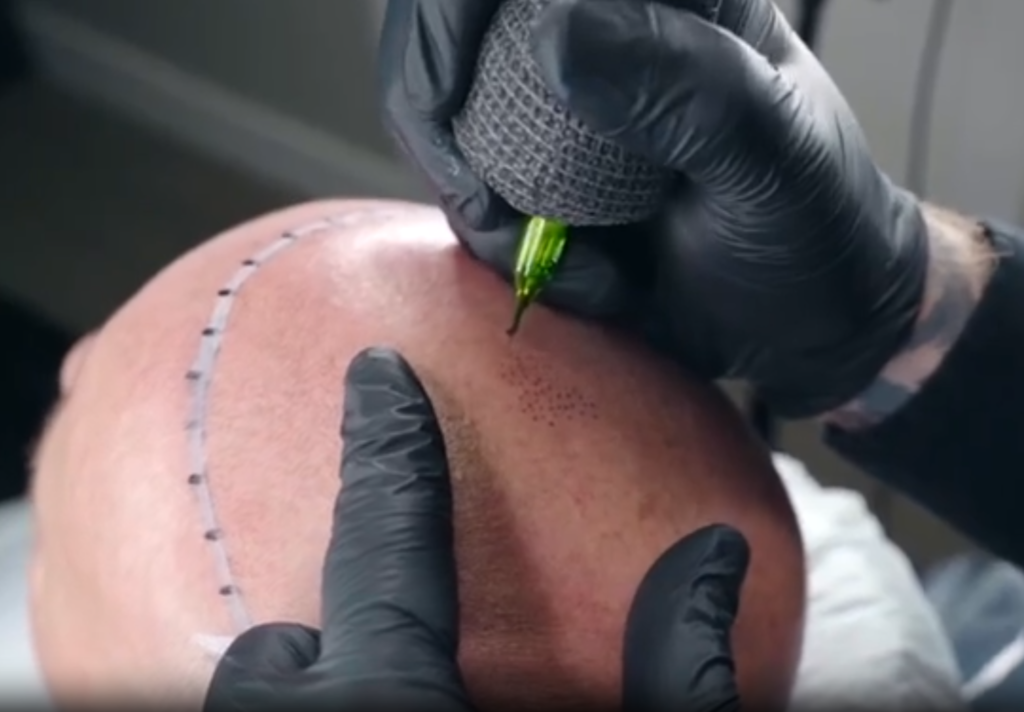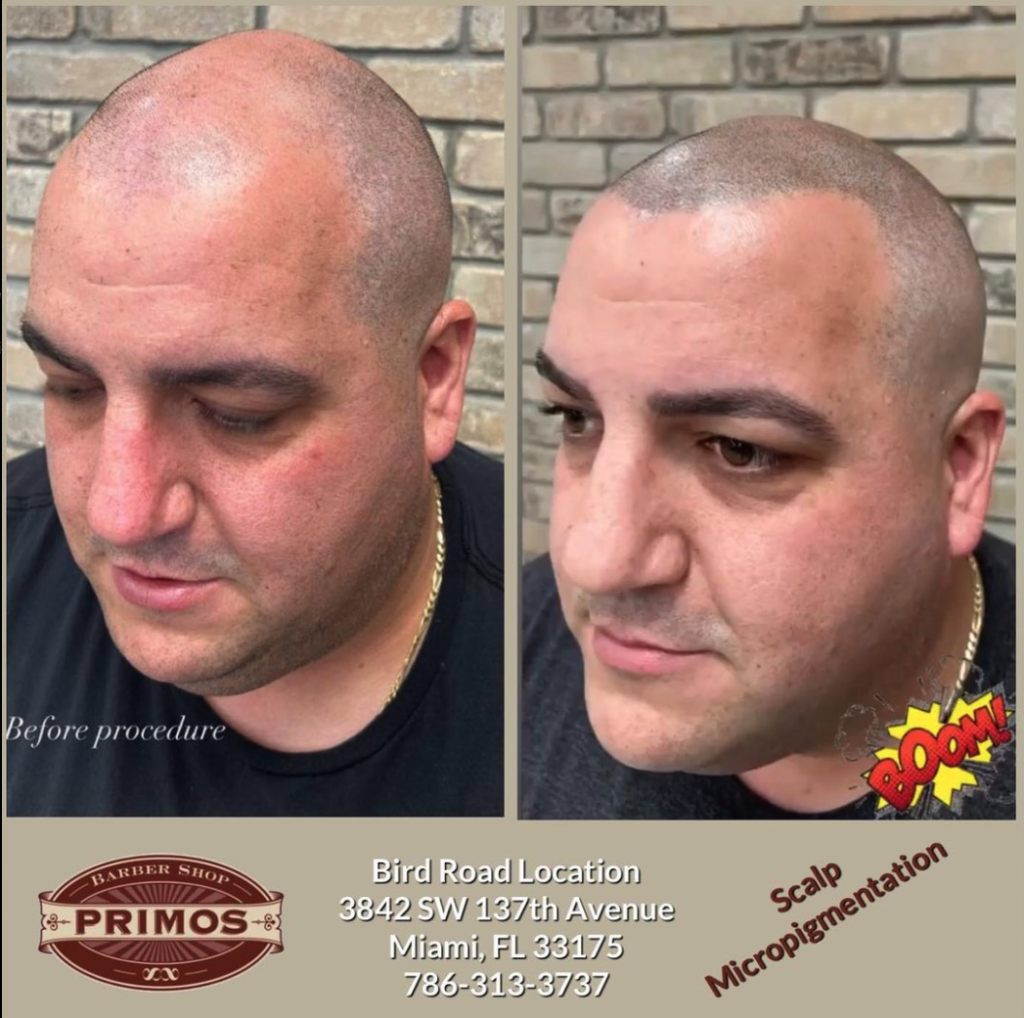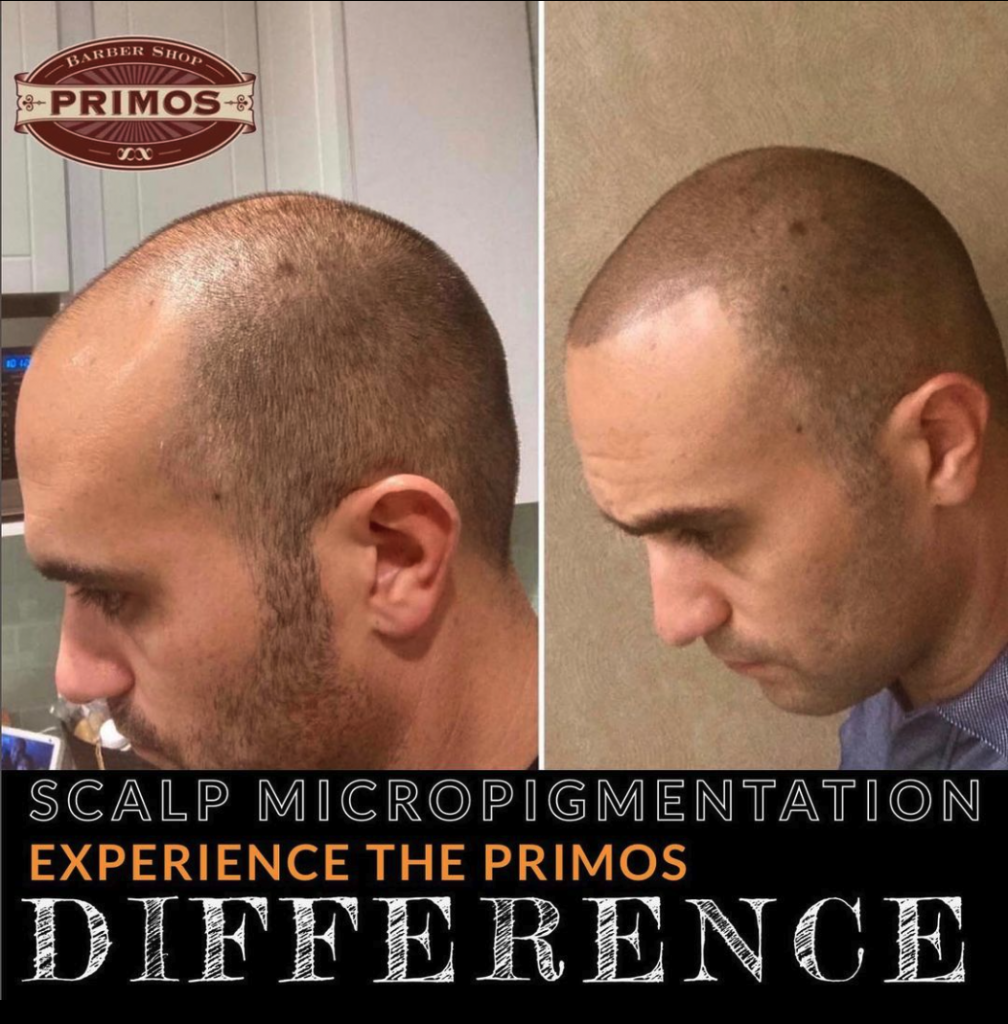
What is Scalp Micropigmentation?
Hair loss affects millions of people worldwide, and it can have a significant impact on their self-esteem and confidence. According to the American Hair Loss Association, by the age of 35, two-thirds of American men will experience some degree of appreciable hair loss, and by the age of 50, approximately 85% of men have significantly thinning hair. Women are not immune to hair loss either, with around 40% of hair loss sufferers being women. Enter scalp micropigmentation (SMP), a non-surgical hair loss solution that has been gaining popularity in recent years. What is scalp micropigmentation, really?
SMP involves using a specialized technique to deposit pigment into the scalp, creating the appearance of a fuller head of hair. This procedure can be an excellent option for those who are not candidates for hair transplant surgery or who want to avoid the cost and downtime associated with surgical procedures.
Unlike traditional hair transplant surgeries or temporary fixes like wigs, SMP offers a long-lasting and natural-looking remedy. But what exactly is SMP, and how does it work?
WHAT IS SCALP MICROPIGMENTATION (SMP)?

Scalp micropigmentation (SMP), sometimes called a “hair tattoo,” is a non-surgical cosmetic procedure that creates the illusion of thicker, fuller hair. Unlike traditional hair transplants, which involve moving hair follicles from one part of the scalp to another, SMP uses a specialized technique to create a realistic looking shaved head or add density to thinning hair.
Here’s how it works: a trained expert uses a thin needle to deposit tiny dots of pigment into the scalp. These pigments are specially formulated to mimic the appearance of natural hair follicles. By strategically varying the size, depth, and density of these dots, the expert can create a realistic look of a buzz cut or add density to areas with hair loss.
It’s important to differentiate SMP from traditional tattooing. While both involve inserting pigment into the skin, SMP uses a much finer needle and deposits pigment at a shallower depth. This creates a more subtle and natural-looking effect compared to a bold tattoo design. Additionally, the pigments used in SMP are specifically chosen to match your natural hair color and scalp tone, further enhancing the realistic appearance. The procedure typically causes less discomfort compared to traditional tattoos as the pigment is not inserted as deeply into the skin.
BENEFITS OF SCALP MICROPIGMENTATION (SMP)
For many people experiencing hair loss, scalp micropigmentation (SMP) offers a compelling alternative to traditional solutions. Here’s a closer look at the key benefits that make SMP an attractive option:
CREATE THE LOOK OF THICKER, FULLER HAIR
Perhaps the most sought-after benefit of SMP is its ability to create the illusion of denser hair. By strategically depositing pigment dots that mimic hair follicles, SMP can significantly improve the appearance of thinning hair, especially for those with mild to moderate hair loss.
CONCEAL BALD SPOTS AND SCARS
SMP isn’t just for those with thinning hair. It can also be a great solution for concealing bald spots and scars on the scalp. The pigments used can effectively camouflage these imperfections, creating a more uniform and aesthetically pleasing appearance.
NON-SURGICAL AND MINIMALLY INVASIVE PROCEDURE
Unlike hair transplants, which involve surgery and potentially lengthy recovery times, SMP is a non-surgical and minimally invasive procedure. This translates to less discomfort, minimal downtime, and a quicker return to your daily routine.
LOW MAINTENANCE COMPARED TO HAIR TRANSPLANTS
Hair transplants require ongoing maintenance, such as medication and regular checkups. SMP, on the other hand, is a low-maintenance solution.
After completing the initial sessions and touch-ups, you need minimal upkeep to maintain the desired results.
POTENTIAL BOOST IN CONFIDENCE AND SELF-ESTEEM
Hair loss can significantly impact a person’s confidence and self-esteem. The realistic and natural-looking results of SMP can significantly improve how you feel about your appearance. Seeing a fuller head of hair, even if an illusion, can lead to a renewed sense of confidence and self-worth.
These are just some of the key benefits that make scalp micropigmentation an attractive option for those seeking a non-surgical solution to hair loss.
WHO IS A GOOD CANDIDATE FOR SCALP MICROPIGMENTATION (SMP)?
Scalp micropigmentation (SMP) isn’t a one-size-fits-all solution, but it can be a great option for a variety of individuals experiencing hair loss. Here’s a breakdown of who might be a good candidate for SMP:
- People with Various Hair Loss Types: SMP can be effective for addressing different types of hair loss, including:
- Male Pattern Baldness: This is the most common type of hair loss in men, characterized by a receding hairline and thinning hair at the crown. SMP can effectively create a realistic shaved head appearance or add density to thinning areas.
- Female Pattern Baldness: While less common than in men, women can also experience hair loss that follows a specific pattern. SMP can be used to camouflage thinning hair on the scalp or create a denser hairline.
- Alopecia: This autoimmune condition causes patchy hair loss. SMP can be a great option for concealing these patches and creating a more uniform appearance.
- Individuals Seeking a Non-Surgical Solution: If you’re looking for a way to address hair loss without undergoing surgery, SMP offers a minimally invasive alternative. It avoids the potential risks and extended recovery times associated with hair transplants.
- Those Realistic About Expectations: It’s crucial to understand that SMP creates the look of thicker hair, not actual hair growth. While the results can be incredibly realistic, it’s not a permanent solution to hair loss. Touch-ups may be required every few years to maintain the desired look.
Here are some additional factors to consider:
- Overall Scalp Health: Ideally, your scalp should be healthy and free of any major conditions like psoriasis or eczema before undergoing SMP.
- Hair Loss Stability: If your hair loss is still progressing rapidly, SMP might not be the best option. It’s best to wait for your hair loss to stabilize before considering SMP.
- Realistic Expectations: Having realistic expectations about the outcome is key. SMP can create a natural-looking look of denser hair, but it won’t grow new hair.
Ultimately, the best way to determine if SMP is right for you is to consult with a qualified SMP expert. They can assess your individual situation and discuss your expectations to help you decide if this procedure is the right fit for your hair loss concerns.
THE SMP PROCEDURE: WHAT TO EXPECT?
Scalp micropigmentation (SMP) offers a non-surgical approach to hair loss, but understanding the process itself can be helpful before making a decision. Here’s a breakdown of the typical SMP procedure:
1. CONSULTATION:
This initial step is crucial for discussing your hair loss concerns, desired outcome, and overall suitability for SMP. A qualified expert will assess your scalp health, hair loss pattern, and desired density. They will also explain the procedure in detail, answer any questions you may have, and discuss realistic expectations.
2. SCALP PREPARATION AND COLOR MATCHING:
Before the actual pigmentation process begins, your scalp will be thoroughly cleansed and prepped. The expert will then meticulously match the pigment color to your natural hair color and scalp tone. This color matching ensures a natural-looking and seamless blend with your existing hair.
3. MICROPIGMENTATION APPLICATION:
The SMP application itself is a multi-step process, often requiring multiple sessions to achieve the desired results. During each session, the expert uses a specialized machine with a very fine needle to deposit pigment dots into the scalp. The size, depth, and density of these dots are meticulously controlled to create a realistic illusion of hair follicles. The number of sessions needed will vary depending on the extent of hair loss and desired density.
4. AFTERCARE INSTRUCTIONS:
Following the SMP procedure, you’ll receive specific aftercare instructions from your expert. These typically involve keeping the scalp clean and avoiding strenuous activity or excessive sweating for a set period. Following these instructions carefully will help ensure optimal healing and results.

IMPORTANCE OF CHOOSING A QUALIFIED “EXPERT”:
It cannot be overstated that choosing a qualified and experienced SMP expert is paramount. Look for experts who are certified by reputable organizations and have a proven track record of successful SMP procedures. Reviewing before-and-after photos from their previous work can also be a good indicator of their skill and experience.
By understanding the consultation, preparation, application, and aftercare process involved in SMP, you can make a more informed decision about whether this approach is right for you. Remember, choosing a skilled and experienced expert is key to achieving natural-looking and successful results.
POTENTIAL RISKS AND SIDE EFFECTS OF SCALP MICROPIGMENTATION (SMP)
While scalp micropigmentation (SMP) offers a promising solution for hair loss, it’s important to be aware of the potential risks and side effects involved. Here’s a breakdown of what to consider:
- Infection: Since SMP involves puncturing the scalp with needles, there’s a small risk of infection if proper sanitation practices aren’t followed. This risk is significantly minimized by choosing an expert who prioritizes a sterile environment and uses disposable needles.
- Allergic Reaction to Pigment: As with any cosmetic procedure involving pigments, there’s a slight chance of an allergic reaction. A reputable expert will likely perform a patch test beforehand to minimize this risk.
- Unsatisfactory Results: Perhaps the most significant risk is achieving an unsatisfactory outcome. This is why choosing a qualified and experienced expert is crucial. A skilled professional will have the expertise to create a natural-looking and customized result based on your scalp condition, hair loss pattern, and desired density. Uneven pigmentation, unnatural hairline shapes, or colors that don’t blend well with your natural hair can occur with an inexperienced expert.
- Not a Permanent Solution: It’s important to understand that SMP is not a permanent solution to hair loss. Over time, the pigments can fade, requiring touch-up sessions every few years to maintain the desired appearance. Sun exposure and certain lifestyle factors can also accelerate fading.
Here are some additional factors to consider:
- Scarring: While uncommon, there’s a slight possibility of minor scarring, especially if the procedure is not performed correctly.
- Swelling and Redness: Temporary swelling and redness at the treated area are normal after the procedure and typically subside within a few days.
Minimizing Risks:
By choosing a qualified and expert who adheres to strict hygiene protocols, you can significantly minimize the potential risks associated with SMP. Researching the expert’s experience, qualifications, and reviewing before-and-after photos can help you make an informed decision.
Remember, open communication with the expert is key. Discuss your concerns and expectations thoroughly to ensure you’re a good candidate for SMP and achieve the desired results.
WHY CHOOSE PRIMOS BARBER SHOP IN MIAMI?

At Primos Barber Shop, we’re Miami’s premier destination for scalp micropigmentation. Our experienced technicians are at the forefront of SMP techniques and equipment, ensuring you receive a customized treatment for a natural-looking, fuller hairline. Don’t settle for anything less than the best – contact Primos Barber Shop today for a free consultation and see how SMP can transform your confidence!
